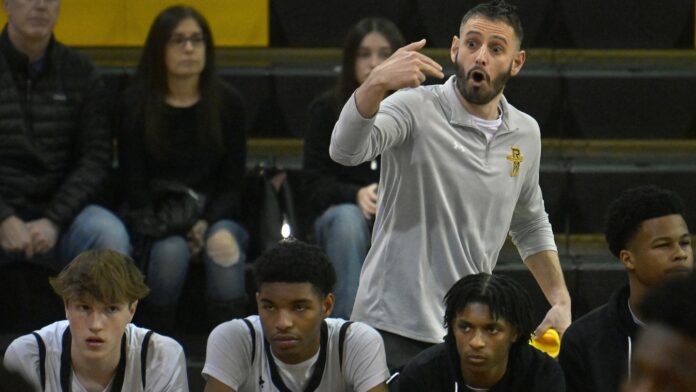By putting the row of folding chairs between him and the court, Breslaw bucks the well-established positioning of basketball coaches. They are faced with myriad decisions during games. Do I call a timeout? Whom should I substitute in? What play should we run?
They also, often subconsciously, constantly ask and answer one more: “Where should I be?”
“No one’s ever talked to me about this,” Breslaw said.
He doesn’t recall when he first went behind the bench, but he does so whenever there’s enough space. Richard Montgomery’s cavernous gym offers plenty for him to roam.
Traditionally, coaches take the seat on the bench closest to the scorers’ table. Next to them are assistant coaches and then come the players, often unofficially ordered by their spot in the rotation.
The distance between the coaches and the players at the end of the bench can let the latter group, usually younger players, get into tangential or entirely unrelated conversations. Breslaw knows this all too well — he did just that as a sophomore at St. Andrew’s.
To prevent such behavior from his players, he used to sit in the middle of the bench. But that posed two problems.
The first was that if he wanted to talk to a player, he had to stand up and turn around, taking his eyes off the court. The second is more relatable: “My back kills me when I sit down,” he said.
Even coaches who don’t endure such pain face important choices on sitting or standing. Their decisions reveal how they view their team’s psyche.
Blake boys’ coach Desmin Wade stands because he has a young, up-tempo squad that welcomes the intensity. Whitman girls’ coach Peter Kenah would rather sit, saying it keeps his players calm, but he acknowledged that’s partly because he has a more experienced team.
Some coaches just can’t help themselves.
Sherwood girls’ coach Tammy Ross is too anxious to stay seated. Gaithersburg boys’ coach Jeff Holda sits for as long as he can — saying it makes him look more objective and calm — but often bounds up. He believes his players think he’s more invested when he’s standing.
South River girls’ coach Mike Zivic has attention-deficit/hyperactivity disorder, giving him a nervous energy that keeps him up. He’s also 6-foot-4, which means he frequently blocks the view of players and coaches on the bench.
“My assistant coach smacks me on the leg half the time. … He always tells me he has a great shot of my butt,” Zivic said.
Coaches who stand usually move with the flow of the game, heading toward the side of the court with the ball or toward the players and referees they need to talk with. Zivic keeps his water bottle on the scorers’ table. He can’t entirely explain why, other than he feels he would kick it if it were on the floor — plus, going for a drink incentivizes him to check on pertinent stats.
Breslaw often inches toward the scorers, making sure they can hear his calls for substitutions. He also keeps an eye out for potential errors in timeouts, fouls or points.
“That actually happens a lot more than people realize. You watch games and you’re like, ‘Oh, my God, they never gave us that point,’ ” he said. “No one in the gym of a thousand people noticed. Or they did notice [and] it didn’t matter because the right people didn’t notice. It happens a lot.”
He re-watched a recent Rockets game and realized they weren’t awarded two points they had scored. Thankfully, they won by 10.
At Blake, Wade stalks the sideline to confer with his assistants. Three sit next to him, one sits in the middle of the bench, and one goes to the end. The one in the middle, Corey Wood, is a former point guard and the team’s player development specialist.
Wade and Wood’s slight physical separation gives the Bengals a subtle advantage.
“If our point guard isn’t making the right reads, I’ll go holler at [Wood]. … He could be seeing something totally different from me from the angle where he is,” Wade said.
Having conversations about various aspects of the game — especially substitutions — allows Blake’s coaches to maximize their team’s timeouts, spending them delivering a message to players rather than finalizing it among themselves.
At the end of the day, that’s what coaching is — identifying and maximizing an edge to put players in the best position for their and the team’s success.
That idea is often limited to how coaches can affect players, but it extends up and down — and even behind — the bench.



